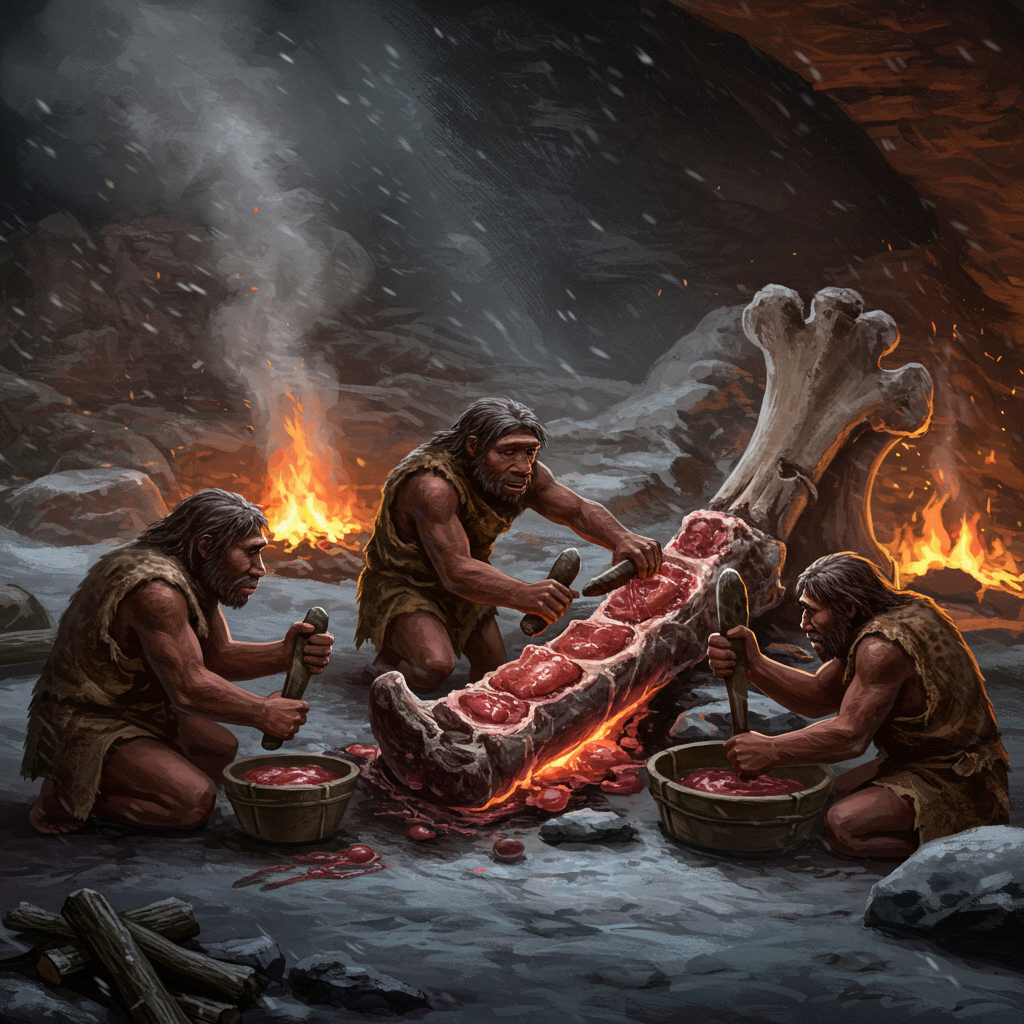Astonishing new archaeological findings are transforming our understanding of ancient humans. Researchers have uncovered compelling evidence that neanderthals in what is now central Germany developed remarkably sophisticated food processing techniques over 125,000 years ago. Located at the neumark-nord 2 site, this discovery reveals a prehistoric “fat factory” where Neanderthals systematically extracted nutrient-rich bone grease from the remains of large animals. This complex practice suggests a level of planning, resource management, and nutritional knowledge far exceeding previous assumptions about our ancient cousins.
Unearthing the Prehistoric “Fat Factory”
The incredible discovery was made at the Neumark-Nord 2 archaeological site in Saxony-Anhalt, Germany. This area, once a lakeshore 125,000 years ago during the Last Interglacial period, served as a specialized workspace for Neanderthals. The core activity was the extraction of fat from bones. This wasn’t simply cracking bones for marrow, a technique also used by early African hominins. Instead, Neanderthals at this site undertook an intensive, organized process. They crushed bones into tiny fragments. Then, using water and heat, they boiled these fragments. This rendering process allowed them to access bone grease.
Dr. Lutz Kindler, the study’s lead author from MONREPOS (Leibniz Centre for Archaeology), emphasized the strategic nature of the operation. “This was intensive, organized, and strategic,” Kindler stated. “Neanderthals were clearly managing resources with caution.” This involved pre-meditated hunts and the careful transportation of animal carcasses back to this specific lakeshore location. Here, they executed the detailed task of fat rendering in a dedicated area. The site shows clear signs of task-specific activity. It demonstrates that Neanderthals understood the vital nutritional value of fat. They also knew how to efficiently extract it.
Why Bone Grease Was a Dietary Powerhouse
Accessing fat was critically important for prehistoric populations, especially hunter-gatherers. While muscle meat provides protein, large wild animals, like the deer, horses, and aurochs butchered at Neumark-Nord, are often quite lean. Fat provides essential energy and crucial fat-soluble vitamins. It is vital for survival, particularly in environments with seasonal resource scarcity or cold climates.
Bone grease is a highly concentrated source of calories and nutrients. Obtaining it requires significant effort and understanding of animal anatomy and processing techniques. The practice uncovered at Neumark-Nord 2, involving breaking down massive quantities of bone and boiling them, represents a highly efficient method to acquire this valuable resource. This method goes significantly beyond simple marrow extraction. Previous archaeological understanding largely attributed such large-scale bone processing for grease to Upper Paleolithic modern humans. The evidence from Neumark-Nord dramatically pushes back this timeline. It places this advanced nutritional strategy firmly within Neanderthal capabilities thousands of years earlier than thought. This discovery fundamentally alters our understanding of the Neanderthal diet and their adaptive strategies.
Evidence Found at Neumark-Nord
The archaeological evidence at Neumark-Nord 2 is compelling. Excavations revealed a dense concentration of bones from at least 172 large mammals. These bones were found alongside flint artifacts and hammer stones. The concentration is particularly notable near the margin of a shallow pool. This setting suggests water played a role in the processing. The sheer volume of bone fragments indicates large-scale activity. Processing such a quantity would only be worthwhile for extracting valuable resources like fat.
The Neumark-Nord area is remarkable because it preserves an entire interglacial ecosystem. Discovered in the 1980s, subsequent excavations between 2004 and 2009 explored various zones within this landscape. These zones show distinct Neanderthal activities. One area indicates deer hunting and light butchering. Another zone appears dedicated to processing straight-tusked elephants. Neumark-Nord 2 represents a third, specialized zone focused on fat removal and bone grease production. This range of activities within a single landscape provides unique insight. As Prof. Wil Roebroeks of Leiden University noted, seeing these different behaviors together is exceptional. Findings at nearby sites within the complex further highlight the scale of Neanderthal activity. For instance, cut-marked remains of 76 rhinos and 40 elephants were found near Taubach. This paints a picture of Neanderthals as highly capable hunters and processors of large game across their territory.
Reshaping Our View of Neanderthal Capabilities
For decades, Neanderthals were often depicted as brutish, less intelligent precursors to modern humans. The “fat factory” discovery at Neumark-Nord delivers another significant blow to this outdated stereotype. The systematic process of breaking down bones, using heat and water, planning hunts to supply the ‘factory,’ and transporting carcasses demonstrates sophisticated cognitive abilities. It showcases skills in logistics, foresight, and a deep understanding of their environment and resources.
This finding adds to a growing body of evidence revealing the complexity of Neanderthal life. Discoveries at other sites, like the 43,000-year-old Neanderthal fingerprint on a painted stone in Spain or evidence of long-term habitation and resource use in places like Ghamari Cave in Iran, contribute to this new picture. They show Neanderthals were capable of symbolic thought, complex social behaviors, and adaptation across diverse landscapes. The Neumark-Nord site specifically highlights their advanced subsistence strategies and nutritional intelligence. Their ability to maximize food resources, even from difficult sources like dense bone, was crucial for survival in dynamic environments. While their mass hunting of large, slow-reproducing species like elephants and rhinos likely had significant long-term environmental impacts on regional fauna, as Prof. Roebroeks points out, it also underscores their capacity for large-scale coordinated efforts and their impact on the ecosystems they inhabited.
A Glimpse into Advanced Paleolithic Life
The findings from Neumark-Nord offer a profound glimpse into the lives of Neanderthals 125,000 years ago. They were not simply opportunistic scavengers or basic hunters. They were intelligent, resourceful, and capable of complex planning and technical processes. The specialized “fat factory” demonstrates a clear understanding of nutrition and efficient food processing techniques that were key to their adaptation and survival during the Middle Paleolithic period. Pushing back the timeline for bone grease production confirms that innovation in subsistence strategies was not exclusive to early modern humans but was part of the shared, complex story of hominin evolution. This discovery continues to challenge and refine our understanding of the rich tapestry of human history and the remarkable capabilities of our Neanderthal relatives.
Frequently Asked Questions
What exactly was the “fat factory” and how did it work?
The “fat factory” refers to an archaeological site (Neumark-Nord 2) in Germany where Neanderthals systematically processed large animal bones around 125,000 years ago. The process involved crushing bones into small pieces. These fragments were then likely boiled in water using heat. This rendering method extracted valuable bone grease, a highly nutritious resource rich in fat and calories. The site’s location near a former lakeshore suggests water was integral to this process.
Where is the Neumark-Nord site located and why is it significant?
The Neumark-Nord complex is located in central Germany, specifically in Saxony-Anhalt. Its significance lies in its exceptional preservation of an entire interglacial landscape. Unlike many sites that offer only a single snapshot, Neumark-Nord reveals different Neanderthal activity zones across the same ancient environment. This includes areas for hunting different animals and the specialized Neumark-Nord 2 “fat factory.” This allows researchers to study a range of behaviors within one coherent landscape.
How does this discovery change our understanding of Neanderthals?
This finding significantly enhances our view of Neanderthals. It contradicts the outdated stereotype of them as unsophisticated or brutish. The “fat factory” demonstrates complex planning, resource management, and advanced technical skills like bone processing for nutrition. It shows they understood the value of fat and had sophisticated ways to obtain it. By revealing that Neanderthals practiced bone grease production thousands of years earlier than previously thought (before modern humans were believed to have done so), it highlights their intelligence and adaptive capabilities, placing them on more equal footing with early Homo sapiens.




